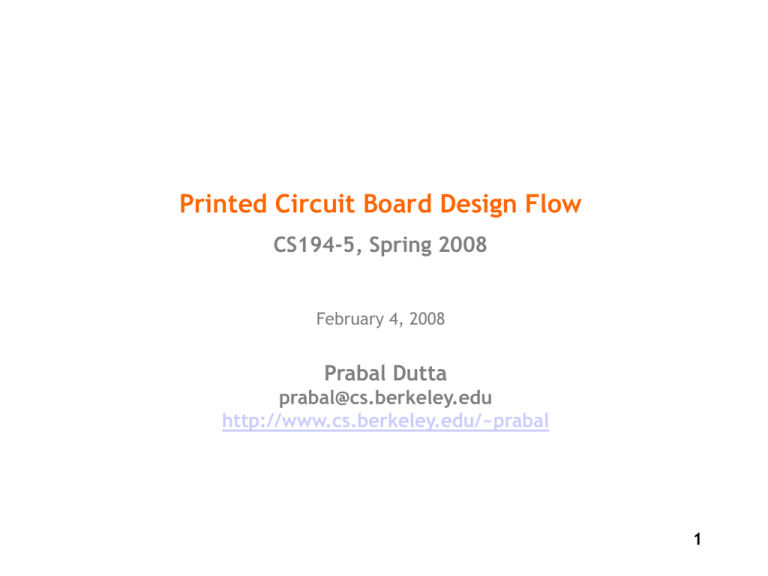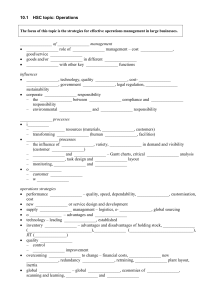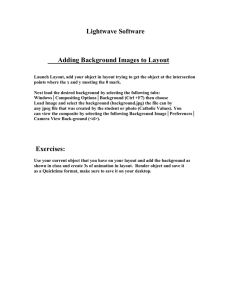PCB Design Flow
advertisement

Printed Circuit Board Design Flow CS194-5, Spring 2008 February 4, 2008 Prabal Dutta prabal@cs.berkeley.edu http://www.cs.berkeley.edu/~prabal 1 A design flow is a rough guide for turning a concept into a real, live working system Inspiration (Concept) Implementation (Working System) “An air-deployable motion sensor with 10 meter range and 6 month lifetime.” 2 Starting with the end in mind: a printed circuit board Copper (pads & traces) Soldermask (green) Drill files (size & x-y coords) Silkscreen (white) Top side Bottom side 3 The cross-section of a PCB shows its layered construction 4 A practical PCB design flow that is action-oriented and artifact-focused Needs Brainstorm Design concepts (multiple) Reqs, Budget, Constraint s Evaluate* Figures, Rankings, Tradeoffs In library, In stock, Standards Constraint s Capability Standards Design Capture Layout (High-level) (Logical Design) (Physical Design) Sys arch, block diag ERC/Sim, Sch/Netlis t BOM DRC, PCB Files, MFG Files *evaluate through models, prototypes, and discussions 5 Brainstorming • Goal: generate as many ideas as possible! • Use the “needs” as the rough guide • Do not (yet) be limited by constraints or formal requirements • Ideally, brainstorm in a group so diversity of perspectives emerge 6 Brainstorming example: energy metering in sensor networks • Need: measure the energy consumed by a mote • Brainstorm • Resulting design concepts – – – – Single-chip battery “fuel gauge” High-side sense resistor + signal processing Low-side sense resistor + signal processing Pulse-frequency modulated switching regulator 7 Requirements and constraints address the myriad of important details that the system must satisfy • Requirements address: – – – – – – Functionality Performance Usability Reliability Maintainability Budgetary • Requirements may be at odds! • Use correlation matrix to sort things out in this case 8 Evaluation • • • • Goal: identify best candidates to take forward Use requirements and constraints as the metric Get buy-in from stakeholders on decisions Also consider – Time-to-market – Economics • Non-recurring engineering (NRE) costs • Unit cost – Familiarity – Second-source options • If none of the candidates pass, two options – Go back to brainstorming – Adjust the requirements (hard to change needs though) 9 Evaluation example: energy metering in sensor networks Requirements: Low High Low High Low Cost Accu Power Rez Pert. N Y N Y Y High-side sense resistor N + signal processing Y N Y Y Low-side sense resistor Y + signal processing Y Y Y N PFM switching regulator Y Y Y Y Y Design concepts Energy meter IC 10 Evaluation example: energy metering in sensor networks Accuracy / linearity are really important for an instrument Sometimes a single experiment or figure says a lot 11 Design • Translate a concept into a block diagram • Translate a block diagram into components • Top-down – Start at a high-level and recursively decompose – Clearly define subsystem functionality – Clearly define subsystem interfaces • Bottom-up – Start with building blocks and increasing integrate – Add “glue logic” between building blocks to create • Combination – Good for complex designs with high-risk subsystems 12 Design II • Design can be difficult • Many important decisions must be made – Analog or digital sensing? – 3.3V or 5.0V power supply? – Single-chip or discrete parts? • Many tradeoffs must be analyzed – Higher resolution or lower power? – Higher bit-rate or longer range, given the same power? • Decisions may be coupled and far-ranging • One change can ripple through the entire design – Avoid such designs, if possible – Difficult in complex, highly-optimized designs 13 Design example: energy metering in sensor networks 14 Schematic capture turns a block diagram into a detail design • Parts selection – In library? • Yes: great, just use it! (BUT VERIFY FIRST!) • No: must create a schematic symbol. – In stock? • Yes: great, can use it! • No: pick a different park (VERIFY LEADTIME) – Under budget? – Right voltage? Beware: 1.8V, 3.3V, 5.0V • • • • Rough floorplanning Place the parts Connect the parts Layout guidelines (e.g. 50 ohm traces, etc.) 15 The schematic captures the logical circuit design 16 Layout is the process of transforming a schematic (netlist) into a set of Gerber and drill files suitable for manufacturing • Input: schematic (or netlist) • Uses: part libraries • Outputs – Gerbers photoplots (top, bottom, middle layers) • Copper • Soldermask • Silkscreen – NC drill files • Aperture • X-Y locations – • Actions – – – – – – – – Create parts Define board outline Floorplanning Define layers Parts placement Manual routing (ground/supply planes, RF signals, etc.) Auto-routing (non-critical signals) Design rule check (DRC) Manufacturing Drawings • Part name & locations • Pick & place file 17 Layout constraints can affect the board size, component placement, and layer selection • Constraints are requirements that limit the design space (this can be a very good thing) • Examples – The humidity sensor must be exposed – The circuit must conform to a given footprint – The system must operate from a 3V power supply • Some constraints are hard to satisfy yet easy to relax…if you communicate well with others. Passive/aggressive is always a bad a idea here! • Advice: the requirement “make it as small as possible” is not a constraint. Rather, it is a recipe for a highly-coupled, painful design. 18 Layout: board house capabilities, external constraints, and regulatory standards all affect the board layout 19 Floorplanning captures the desired part locations 20 The auto-router places tracks on the board, saving time 21 Layout tips • Teaching layout is a bit like teaching painting • Suppy/Ground planes – – – – – Use a ground plane (or ground pour) if possible Use a star topology for distributing power Split analog and digital grounds if needed Use thick power lines if no supply planes Place bypass capacitors close to all ICs • Layers – Two is cheap 22 Discussion? Questions? 23 There are lots of design flows in the literature but they are awfully general 24



